On first glance, Nioh does not seem remarkable. A generic looking action RPG in the vein of Dark Souls, Nioh seems more like a lost Playstation 2 curiosity than a killer AAA exclusive. Ignoring it would be a terrible mistake though. Nioh is one of the best action titles in years, packed with exciting combat and genuine heart.
Developer Team Ninja had fallen from grace after a string of lifeless Dead or Alive titles and the tepid Yaiba: Ninja Gaiden Z. With Nioh, the team has mined an absolute gem of action combat and challenge.
Nioh follows the tale of Englishman William Adams on a journey across Japan during the Warring States period. The historical William Adams was Japan’s first Western samurai, and his strange life history takes a fantasy turn in Nioh, transforming him into a wandering slayer of yokai who also plays a pivotal role in the military campaigns of Tokugawa Ieyasu. The devious alchemist Edward Kelley has stolen William’s spirit companion. The quest to rescue her places William right in the middle of Japan during the birth of a new era.
The emphasis on Japanese history and myth merges historical fiction and magical epic to create an infectious world full of interesting characters and monsters. Nioh struggles with telling a cohesive story but the setting and its various affectations provide a suitable arena for epic combat.
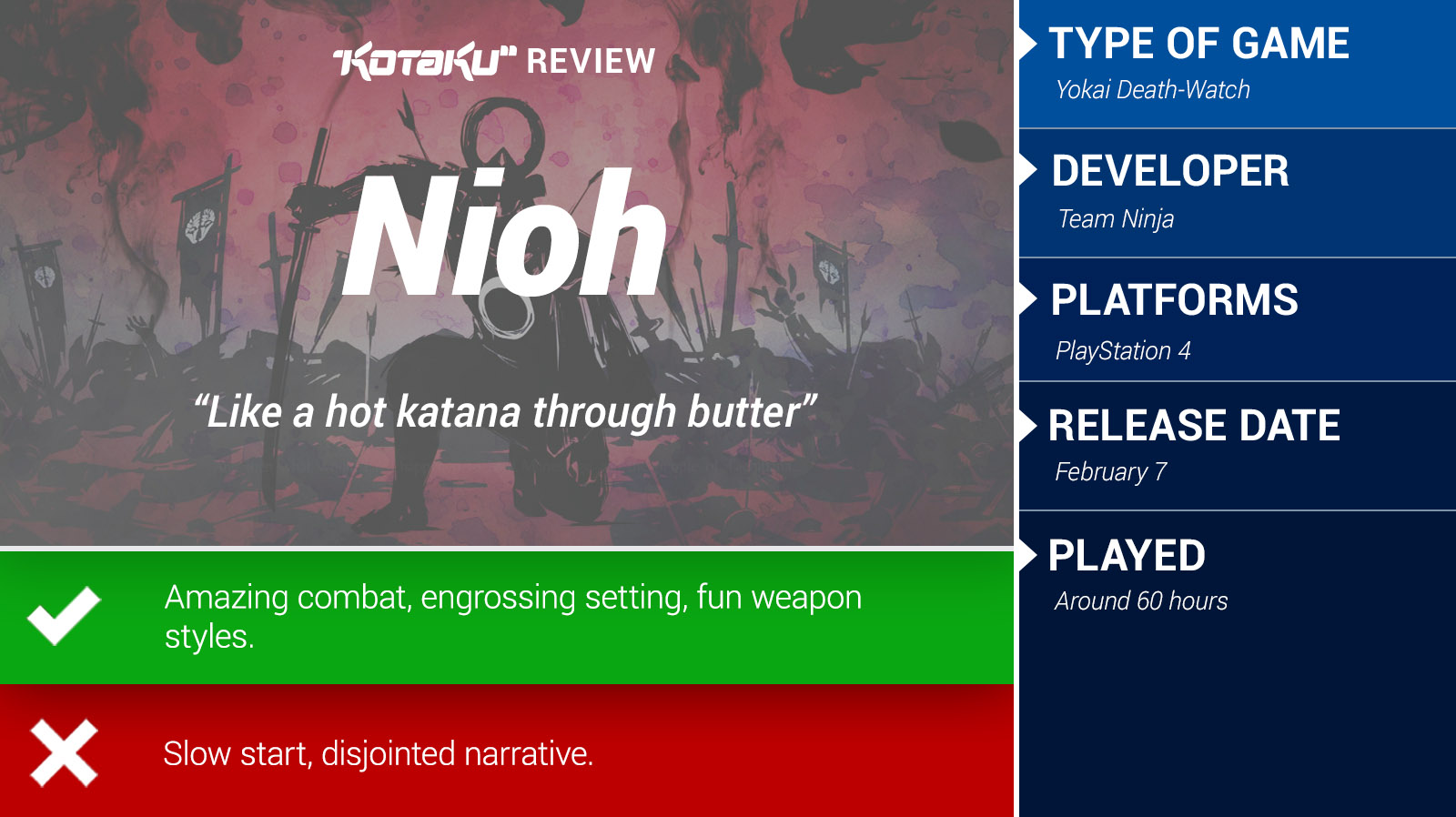
Fighting in Nioh is absolutely sublime. It is genuinely difficult to think of a superior system. A confluence of interweaving systems and mechanics make for fast-paced gameplay rife with tactical possibilities. On a basic level, the game plays like Bloodborne on ecstasy, full of quick dodges, furious chain attacks, and rapid weapon switching. These strong fundamentals are then augmented with additional flourishes.
Chief among these is an ability known as Ki Pulse. Attacks deplete the player’s stamina gauge; full depletion leaves you vulnerable to fatal counter attacks. A well-timed button press allows for the recovery of a varying amount of stamina depending on the timing. This allows players to further press the offensive and gives a clear rhythm to the combat. Nioh is a fast game, and it gives players the tools to maintain that breakneck pace so long as they remain focused.
Weapon stances further vary things up. Players are armed with katanas, dual sword, spears, and more, all of which have a strong, medium, and light stance. A lighter spear stance can transform the player into a whirling hurricane of frenzied attacks, while a strong katana stance will hit hard and punish guarding opponents.
Players will undoubtedly find a favourite weapon and stance, but the breadth of options means there’s always a means to counter difficult foes. A character progression system that includes craftable ninja tools like shuriken or poisons and magical spells to slow enemies attacks or add elemental effects to your weapons offers additional tactics for facing enemies.
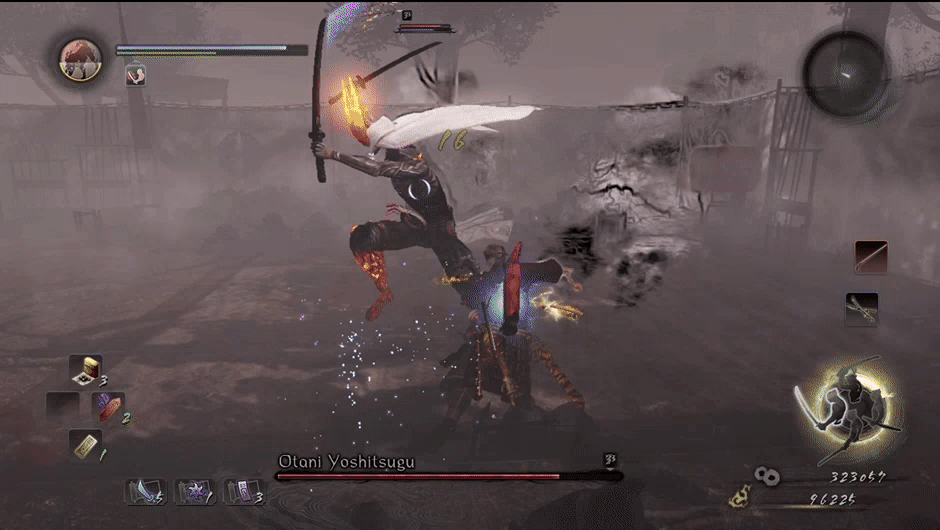
Combat is a might of dodging, mad slashes, magic, and various stances.
Using all the tools at your disposal is incredibly important. Nioh is a difficult game. It’s never unfair or cruel, but it is challenge. Even the most basic of enemies can surprise with feints and intelligent guarding. Terrifying yokai can seed the ground with pulsating energy that stymies stamina recovery and greatly increases damage. Well-timed Ki Pulses dispel this dark force, turning encounters with even the lowliest of demons into a tense battle for positioning. A single misstep can spell disaster.
Of course, the greatest foes are the game’s bosses. A seemingly never-ending supply of yokai, mercenaries, samurai, and yurei will block your path. The most challenging encounters are traditional sword fights, of which the game provides plenty. Larger bosses often exhibit inspired visual designs, but they don’t manage to impress half as much as a simple duel between two samurai.
Many of these bosses have roots in history, and you learn about them while exploring levels. You fight a yuki-onna spirit who was the wife of notorious general Oda Nobunaga. You cross swords with famed warrior monk Saika Magioichi, renowned for his skill with rifles. You train your ninja skills against Hattori Hanzo. This additional context makes each battle feel ripped from the pages of legend, and gives each encounter an epic atmosphere.
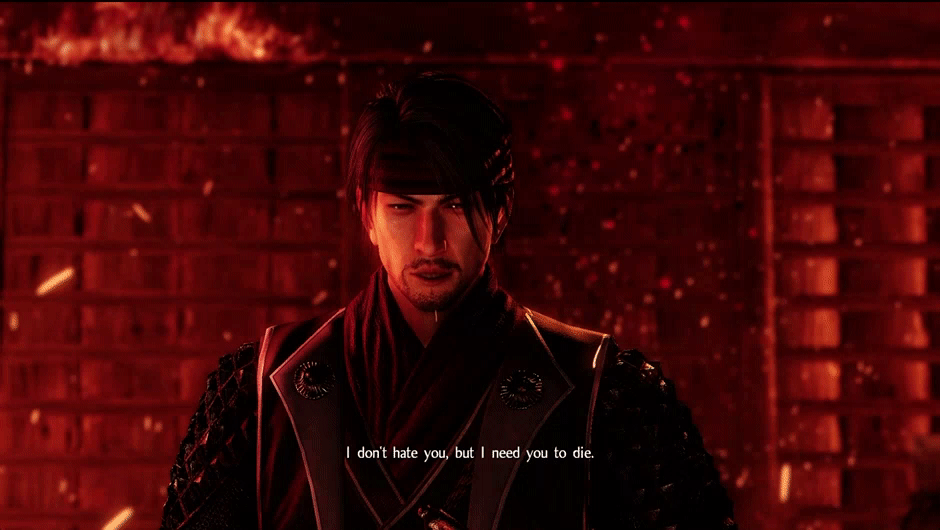
The history has been embellished but Nioh’s style is captivating.
At times, Nioh complicates boss fights with additional gimmicks. Lighting hidden torches in a level might ignite braziers in a boss arena, which can be used to imbue your weapons with fire magic. Supernaturally-powered samurai channel energy from nearby crystals that must be destroyed. These attempts to break up the action don’t always feel necessary when the core gameplay is plenty of fun on its own. In fact, these gimmick battles are often some of the game’s worst fights. They slow the pace and distract from the strong core mechanics.
Luckily, Nioh is massive, so these low points never last long. After a middling tutorial at the start, the game expands to offer a main progression path as well as countless side missions that offer additional variety to the gameplay. These run the gamut from target assassinations to exhaustive survival modes against waves of enemies. A few even contain special bosses and enemies.
Experiencing Nioh to the fullest is a major time investment, but the excitement and challenge never wear off even dozens of hours down the line. It’s very easy to get lost in dojo training and the highly difficult Twilight missions, which offer tempting rewards and even more dangers than the main story.
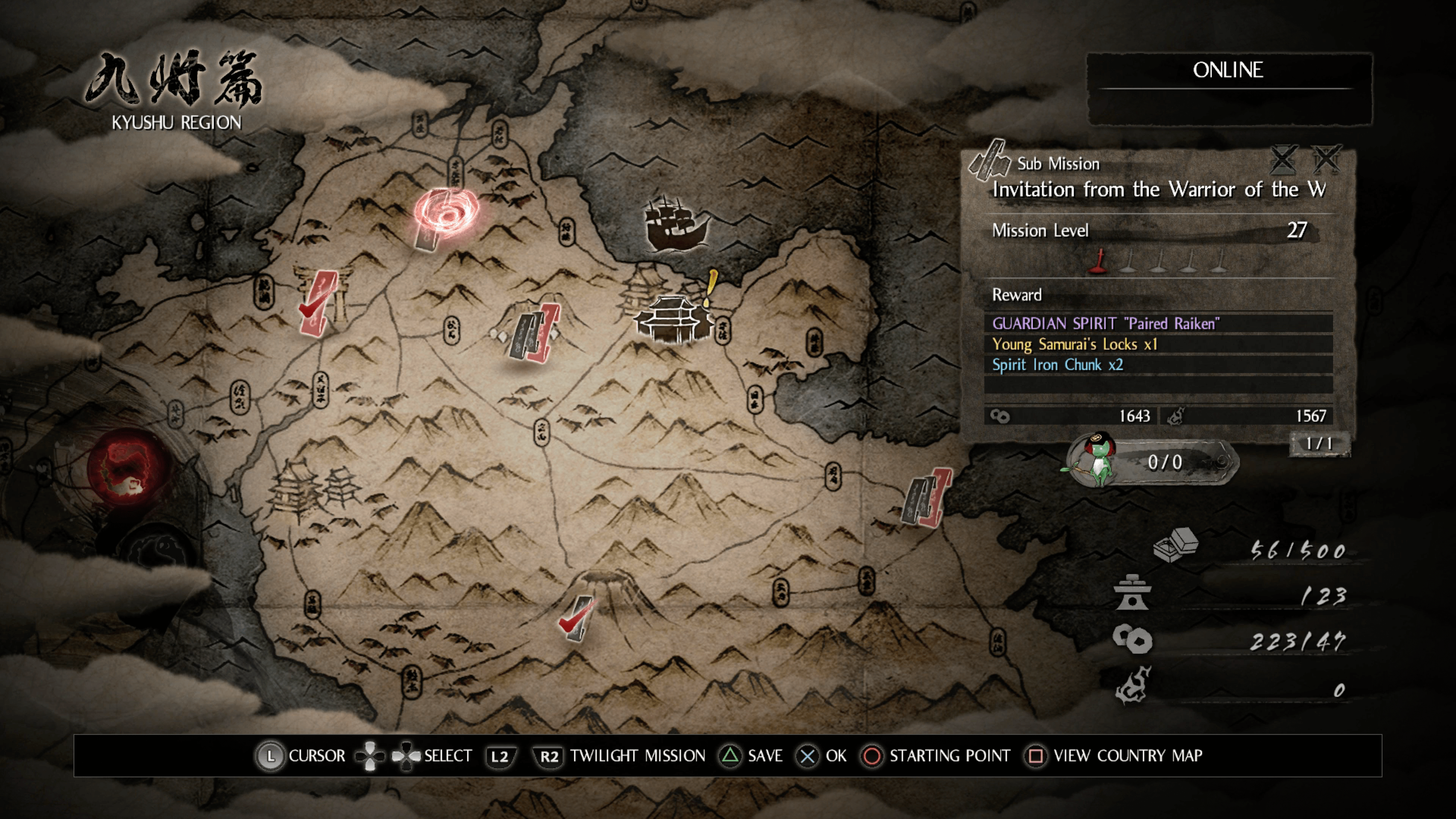
Nioh offers numerous side actives and challenges alongside the main story.
You won’t have to journey alone either. Players can travel together through realms with boosted difficulty in search of loot or randomly join others to help them fight against bosses. An asynchronous multiplayer feature also populates levels with the graves of fallen players. Deadly AI revenants can be summoned from these graves, proving a challenging fight against highly deadly spirit versions of deceased players that offer loot upon defeat.
If Nioh has a cardinal sin, it is that while it is packed with amazing gameplay and novel systems, the experience itself can feel disjointed. There’s a lot to do, but it rarely feels coherent. You journey from level to level with only the vaguest sense of what is going on in the plot. Nioh‘s development history is a clumsy one, originally starting as a media project based on an unfinished Akira Kurosawa film. It would appear that years of reshuffling and shifting development left the somewhat fractured. It never completely diminishes the experience, but it can occasionally cause confusion.
Nioh is one of the most memorable and competent action games in a long time. There’s a genuine speed to combat, and the mixture of stances, magic, and other options turns any battle into a violent crescendo of action. It rockets players from challenge to challenge, remaining consistently exciting throughout. Nioh is a focused powerhouse of samurai action and folk whimsy that surpasses games like Dark Souls and brings a truly fast and dynamic pace to action-RPGs.
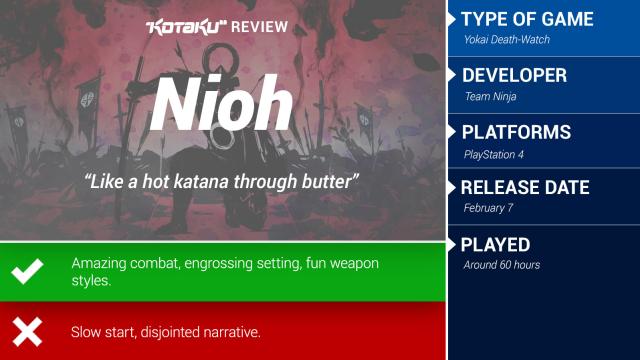
Comments
3 responses to “Nioh: The Kotaku Review”
I get a bit fatigued playing bloodborne and souls (still enjoy both a lot), but Nioh is a lot more fun while presenting the same challenge. The characters are light and there is this whimsy to the setting rather than the bleak worlds of From’s games. The mission structure with both long and bite sized maps, diablo loot and frenetic, difficult combat all appeal to me greatly. Even “freed from this mortal coil” on death kind of makes me smirk still. Love the game, loads of fun and hard as hell at times.
It’s funny how having a living world can change the feeling so much.
The little Kodama buddies can always put a grin on my face with their little parties or finding them relaxing in a hot spring.
I hope there is a Kodama hat somewhere.
Agreed. As much as I love Bloodborne and the Soul series, it’s very depressing with no reprieve. Nioh provides the difficult combat of Souls with the classically strange Japanese humour you see in some of Studio Ghibli’s best work.